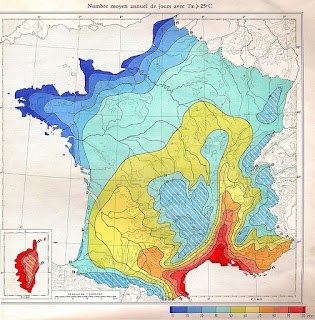Showing posts with label php. Show all posts
Showing posts with label php. Show all posts
19 July 2015
New forecast data upgrade for the Météo website (#5)
This blog has moved to https://blog.sverrirs.com/2015/07/new-forecast-data-upgrade-for-meteo.html
Labels:
be the change
,
france
,
fun
,
php
,
projects
7 July 2015
Météo France, converting between different wind speed units (#4)
 The small Météo France site I created has been updated with a new parameter that can be used to customize the unit that windspeed is presented as.
The small Météo France site I created has been updated with a new parameter that can be used to customize the unit that windspeed is presented as.The u= parameter
The new parameter that controls the windspeed is ?u= and accepts the following values:| Value | Comment | Examples |
| u=bf | Beaufort scale of windforce between 0 and 12. More information about conversions. Unit "F" |
Try it |
| u=ms | Meters per second. Unit "m/s". | Try it |
| u=kn | Knots. Unit "kn". | Try it |
| u=kmh | Kilometers per hour. Unit "km/h". This is the current default. | Try it |
More information on conversion and meaning of these different scales can be found here and on Wikipedia.
This parameter works both for the website as well as the weather API service.
Examples
 |
| Knots Kn |
 |
| Beaufort Force F |
 |
| Kilometers per hour Km/h |
 |
| Meters per second m/s |
5 July 2015
Expanding the Météo weather forecast site (#3)
 I've discussed the work I've done to build a simpler weather UI for the French météo service in earlier posts (first entry and second entry).
I've discussed the work I've done to build a simpler weather UI for the French météo service in earlier posts (first entry and second entry).We've been having exceptionally hot weather and I decided to expand the current web app with more information that is provided by the French weather service.
Try it
Severe weather warnings
The Météo service publishes a separate list of areas that have been issued with severe weather warnings (vigilance météorologique). I thought it might be helpful to have this information readily available to the user.After fruitlessly attempting to scrape the HTML on this website and being unable to locate the same elements that the browser debuggers indicated were rendered. I discovered to my dismay that most of the content on these pages are being rendered by a client side JavaScript. Why, I will probably never understand as the code is quite the mess to look at.
But luckily I noticed that the whole rendering depended on a single XHR call to an external XML service that luckily didn't require any sort of CrossSite authentication. So I simply went straight to the source and saved countless hours of debugging and fiddling with bad HTML. (http://vigilance.meteofrance.com/data/NXFR33_LFPW_.xml)
Unfortunately the source doesn't really represent the data in any easily understandable way so considerable digging around in the JavaScript code was needed to fully understand all the numerical codes presented in the XML.
 |
| The raw XML data from the Météo service |
Severe gales / strong wind
While digging around and trying to figure the weather warnings out I realized that my earlier design did not account for displaying warning and windspeed numbers for any forcasted and expected wind gales. This information was already available from my earlier parsing project and needed only minimal tweaking to get correct.This information is now presented either within the day or as a whole day event, depending on which is applicable.
 |
| The new information elements. Click for a larger version |
Try it
This article is also available on LinkedIn:
https://www.linkedin.com/pulse/expanding-météo-weather-forecast-site-sverrir-sigmundarson
1 June 2015
Getting hassle free and fast(er) weather forecasts in France (#1)
 The Météo-France Android app has been annoying me for the past 6 months with its excessive battery usage and frustrating UI navigation and experience. Finally this week I had enough and decided to come up with something simple that still gives me the same information on my mobile as the rather excellent France Meteorological office prepares and publishes.
The Météo-France Android app has been annoying me for the past 6 months with its excessive battery usage and frustrating UI navigation and experience. Finally this week I had enough and decided to come up with something simple that still gives me the same information on my mobile as the rather excellent France Meteorological office prepares and publishes.Try it
This project has been updated, click here for part two (that discusses the UI redesign) and part three (data enhancements) of this article.
Design
As the French Météo does not publish any of its data in an easily programmable way I decided to do simple screen scraping of their existing forecast website. This is straight-forward enough to do in PHP and actually made considerably easier using the SimpleHTMLDOM library. I highly recommend it. It is the closest I've come to having BeautifulSoup in PHP.
The service is split into two pages:
API
Scapes and re-renders the Météo data into either a JSON or JSONP format.
Try it
Supports the following URL parameters:
Relies on support data from the following resources:
http://labs.coruscantconsulting.co.uk/strasbourg/meteo/img/spriteCarte40Uvs.png
http://labs.coruscantconsulting.co.uk/strasbourg/meteo/img/spriteCarte40Temps.png
http://labs.coruscantconsulting.co.uk/strasbourg/meteo/legend.css
Try it
Supports the following URL parameters:
| Parameter | Description |
|---|---|
| &area= | Lowercase name of the region or area you're interested in. E.g. strasbourg, eckbolsheim or saverne. Defaults to "strasbourg" |
| &zip= | The zip code for the area. This should correspond to a zip code available in the area used. Defaults to "67000" |
| &callback= | Optional, if used then the call becomes a JSONP response and this value will hold the name of the client side Javascript function that should be called when the call returns. |
Relies on support data from the following resources:
http://labs.coruscantconsulting.co.uk/strasbourg/meteo/img/spriteCarte40Uvs.png
http://labs.coruscantconsulting.co.uk/strasbourg/meteo/img/spriteCarte40Temps.png
http://labs.coruscantconsulting.co.uk/strasbourg/meteo/legend.css
Website presentation
Simple HTML/Javascript front on top of the forementioned API functionality. Supports both AREA and ZIP parameters described above.
Try it
http://labs.coruscantconsulting.co.uk/strasbourg/meteo/index.php
Eckbolsheim weather info in HTML format:
http://labs.coruscantconsulting.co.uk/strasbourg/meteo/index.php?area=eckbolsheim&zip=67201
Saverne API response:
http://labs.coruscantconsulting.co.uk/strasbourg/meteo/api.php?area=saverne&zip=67700
Default API response with JSONP callback:
http://labs.coruscantconsulting.co.uk/strasbourg/meteo/api.php?callback=weatherdatafunction
This acticle is also available on LinkedIn:
https://www.linkedin.com/pulse/getting-hassle-free-faster-weather-forecasts-france-sigmundarson
Examples
Default call in HTML format:http://labs.coruscantconsulting.co.uk/strasbourg/meteo/index.php
Eckbolsheim weather info in HTML format:
http://labs.coruscantconsulting.co.uk/strasbourg/meteo/index.php?area=eckbolsheim&zip=67201
Saverne API response:
http://labs.coruscantconsulting.co.uk/strasbourg/meteo/api.php?area=saverne&zip=67700
Default API response with JSONP callback:
http://labs.coruscantconsulting.co.uk/strasbourg/meteo/api.php?callback=weatherdatafunction
This acticle is also available on LinkedIn:
https://www.linkedin.com/pulse/getting-hassle-free-faster-weather-forecasts-france-sigmundarson
15 January 2015
Filtering the ESA Small & Medium Sized Enterprises on a map (#2)
The project discussed in this article has now been updated with newer data see post 3.
As a follow up on the work I did in an earlier post I decided to go ahead and expand my initial implementation quite a bit in an attempt to make it more useful for people looking for ESA vetoed contracting firms.
Try it
So I implemented two major enhancements:
Super useful. Wow
!
As a follow up on the work I did in an earlier post I decided to go ahead and expand my initial implementation quite a bit in an attempt to make it more useful for people looking for ESA vetoed contracting firms.
Try it
So I implemented two major enhancements:
1. Richer company info
Now when you click on a marker it will show you a much richer details about each company. Specifically its primary fields of expertise and contact information (in case you're interested in working there).2. Filtering of companies
You can now hover over a little blue icon in the lower right-hand corner to open up a filter menu. By selecting individual filters in this menu you can limit the markers shown on the map to only companies that specialize in these fields.Super useful. Wow
!
24 November 2014
ESA Small & Medium Sized Enterprises on a map
This article has been expanded and updated in post 2 and post 3.
Recently I had some business on the European Space Agency (ESA) SME Database. This database lists small and medium sized companies that have been cleared or granted privileges to work as contractors for the ESA.
The primary public access to this database is a long tabular list of company names and addresses. This data can be better presented today by overlaying it on an interactive map instead of a list. Using such a format can also make it easier for people to browse and investigate opportunities in specific areas.
So, in the spirit of being the change you want to see, I set out to create an offline parser (.NET) to source the list of companies from the SME database and then a simple PHP website to render the results onto a nice modern map (in this case Google Maps).
Try it
This first version is very basic. Currently the following improvements are planned
Recently I had some business on the European Space Agency (ESA) SME Database. This database lists small and medium sized companies that have been cleared or granted privileges to work as contractors for the ESA.
The primary public access to this database is a long tabular list of company names and addresses. This data can be better presented today by overlaying it on an interactive map instead of a list. Using such a format can also make it easier for people to browse and investigate opportunities in specific areas.
So, in the spirit of being the change you want to see, I set out to create an offline parser (.NET) to source the list of companies from the SME database and then a simple PHP website to render the results onto a nice modern map (in this case Google Maps).
The change
First version is done and you are welcome to use it:Try it
This first version is very basic. Currently the following improvements are planned
More details about companies shown when the markers are clicked
2015-01-11: Page now shows company fields of expertise as well as contact information- Filter companies by their sector and project types
- Select companies and print a list for future reference (in case you're job hunting)
28 July 2014
Improving the TFL Open Data Feeds and APIs
This blog has moved to https://blog.sverrirs.com/2014/07/improving-tfl-open-data-feeds-and-apis.html
You will be automatically redirected.
Subscribe to:
Comments
(
Atom
)


